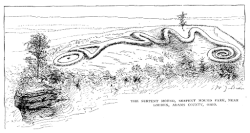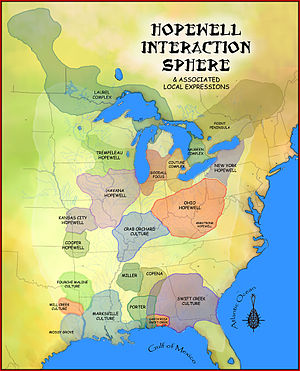Timeline of North American prehistory
This article needs additional citations for verification. (June 2011) |
| Periods in North American prehistory |
|---|
 |

Hopewell Interaction Area and local expressions of the Hopewell tradition
This is a timeline of in North American prehistory, from 1000 BC until European contact.
Timeline[]
- 1000 BC–800 AD: The Norton tradition develops in the Western Arctic along the Alaskan shore of the Bering Strait
- 1000 BC: Athapaskan-speaking natives arrive in Alaska and northwestern North America, possibly from Siberia.
- 1000 BC: Pottery making widespread in the Eastern Woodlands.
- 1000 BC–100 AD: Adena culture takes form in the Ohio River valley, carving fine stone pipes placed with their dead in gigantic burial mounds.[1] See Prehistory of Ohio.
- 500–1 BC: Basketmaker phase of early Ancestral Pueblo culture begins in the American Southwest.
- 500 BC–AD 1000: on the Great Plains[2]
- 300 BC: Mogollon people, possibly descended from the Cochise tradition, appear in southeast Arizona and southwest New Mexico.
- 200 BC–500 AD: The Hopewell tradition begins flourishing in much of the East, with copper mining centered in the Great Lakes region.[1]
- 1 BC: Some central and eastern prairie peoples learned to raise crops and shape pottery from the mound builders to their east.
- 500 BC–700 AD: thrives in the western Arctic
- 50 BC–800 AD: Ipiutak culture thrives in the western Arctic.[1]
- 1 AD: Some central and eastern prairie peoples learned to raise crops and shape pottery from the mound builders to their east.
- 100–1000: Weeden Island culture flourishes in coastal Florida. They are known for their extraordinarily well-preserved wood carvings.
- 200: The Adena culture of the Ohio River valley evolves into the Hopewellian exchange.
- 200–800: Late Eastern Woodlands cultures flourish in the Eastern North America.[1]
- 200–1450: Hohokam cultures flourish in Arizona and north Mexico[1]
- 400: Cultivation of maize (corn) begins in the American Southeastern Woodlands and soon reaches the Northeastern Woodlands. Originally domesticated in Mesoamerica, maize transforms the Eastern Agricultural Complex.
- 400: Ancestral Pueblo peoples of the American Southwest weave extraordinarily long nets for trapping small animals and make yucca fibers into large sacks and bags.
- 500: Late Basketmaker II Era phase of Ancestral Pueblo culture diminishes in the American Southwest.
- 700: Basketmaker III Era of the American Southwest evolve into the early Pueblo culture.
- 755±65 – 890±65: likely dates of the Blythe Geoglyphs being sculpted by ancestral Quechan and Mojave peoples in the Colorado Desert, California[3]
- 700–800: Ancestral Pueblo people of the American Southwest or Oasisamerica transition from pit houses to multi-story adobe and stone apartments called pueblos.
- 800–1500: Mississippian culture spawns powerful chiefdoms of great agricultural Moundbuilders throughout the Eastern woodlands.
- 875: Patayan people begin farming along the Colorado River valley in western Arizona and eastern California.
- 900: Earliest event recorded in the Battiste Good (1821–22, Sicangu Lakota) Winter count[4]
- 900: Ancestral Pueblo culture dominates much of the American Southwest.
- 900: American Southwestern tribes trade with Indigenous peoples of Mexico to obtain copper bells cast through the lost-wax technique.
- 915 (exact date): Construction begins at Pueblo Bonito, the largest Ancestral Pueblo Great House.
- 1000: Discovery of Vinland by Leif Ericson and Norse colonization of North America.
- 1000–1200: Acoma Pueblo and Old Oraibi are established, become the oldest continuously inhabited communities in the United States[5][6][7]
- 1000–1750: Fort Ancient culture, a non-Mississippian culture emerges in modern-day southern Ohio, northern Kentucky, southeastern Indiana, and western West Virginia.
- 1000–1780: Plains Village period on Great Plains, from North Dakota to Texas[2]
- 1070: Great Serpent Mound built in Ohio.[8]
- 1100: Pueblo Bonito in Chaco Canyon reaches apex in size at 800 rooms[9]
- 1100: Hohokam culture reaches apex in present-day Arizona[9]
- Scandinavians briefly settled Vinland (likely l'Anse aux Meadows on the Canadian Maritime island of Newfoundland) early in the century and perhaps ventured as far south as New England.
- The Thule people began absorbing the old Dorset culture in Arctic Alaska.
- 900–1150: Pueblo II Era in the American Southwest[10]
- 1000–1200: Early Mississippian culture in the Eastern Woodlands[11]
- 1000–1200: Acoma Pueblo and Old Oraibi are established, and become the oldest continuously inhabited communities in the United States[12][13][14]
- 1142: League of the Iroquois is founded, and the Great Law of Peace is adopted by the Mohawk, Seneca, Cayuga, Onondaga, and Oneida people.[15] Wampum invented by Ayenwatha, which the Haudenosaunee used to record information.[16]
- 1150–1350: Pueblo III Era in the American Southwest[17]
- The Inuit Thule people largely displaced the old Dorset culture in Arctic Alaska.[18][19]
- The most important city of the Mississippian culture of mound builders, Cahokia on the Mississippi River opposite modern Saint Louis, Missouri, reached its zenith. It was the largest city in North America in the 12th century.[20]
- 1150–1350: Ancestral Pueblo people are in their Pueblo III Era
- 1200: Construction begins on the Grand Village of the Natchez near Natchez, Mississippi. This ceremonial center for the Natchez people is occupied and built upon until the early 17th century.[21]
- 1200–1400: Middle Mississippian culture flourishes in the Eastern Woodlands
- 1250: Pensacola culture emerges in Florida
- 1250: Cliff Palace, Mesa Verde, and other Ancestral Pueblo architectural complexes reach their apex[22]
- The Inuit Thule people have completely displaced the old Dorset culture in Arctic Alaska.
- Pueblo people in the American Southwest evacuate most above-ground pueblos to build spectacular cliff dwellings housing hundreds of people.
- The dominant Ancestral Pueblo begin gradually absorbing the Mongollon culture in the American Southwest.
- Athapaskan-speaking people begin migrating from the prairies of Alberta and Montana toward the American Southwest.
- The Four Corners area of the American Southwest suffered severe droughts late in the century, causing many Pueblos to abandon their cliff dwellings for irrigable settlements along the Rio Grande in southern New Mexico.
- 1300: Cliff Palace is abandoned.[23][24]
- 1200–1400: Middle Mississippian culture in the Eastern Woodlands
- 1315–1317: The Little Ice Age brought a period of severe decline to medieval Europe, causing the Great Famine.
- The 14th century in America probably also brought decline of the Mississippian culture, especially in the northern states. Dendroclimatology suggests that severe droughts ravaged the American Southwest and especially the Southern Plains early in the period, leading to a rapid cultural decline.
- Athapaskan-speaking people continue to migrate southward from the Canadian prairies toward the American Southwest.
- Athapaskan-speaking Apache and Navajo reach the American Southwest after migrating over three centuries from the western Canadian prairies.[citation needed]
- Mississippian culture (Pensacola culture, Plaquemine culture, Lake George Phase, Fort Walton culture)
- Late Woodland Southeast (Alachua culture, Suwannee Valley culture)
- Safety Harbor culture
- 1492: Christopher Columbus sails to India and stumbles on to the American continent (first European contact on the American continent since the Norse colonization of North America 500 years earlier.
- 1497: Italian navigator John Cabot sails from England to Newfoundland.
See also[]
Notes[]
- ^ Jump up to: a b c d e "North America, 1000 b.c.–1 a.d." Heilbrunn Timeline of Art History. (retrieved 19 June 2011)
- ^ Jump up to: a b Barry Gwin Williams, "Cultural Resources Overview: Lake Andes National Wildlife Refuge – Southeast South Dakota," US Fish and Wildlife Service: Region 6 – Cultural Resource Program (Jan. 2012), DOC.
- ^ Malki Museum. Journal of California and Great Basin Anthropology. 1994. Volume 16, Issue 1: 63
- ^ Greene, Candace S. and Russel Thornton, ed. The Year the Stars Fell: Lakota Winter Counts at the Smithsonian. Washington, DC: Smithsonian Institution, 2007. ISBN 0-8032-2211-4, p. 42
- ^ [1]
- ^ Ancient Citadel. Smithsonian Magazine. April 2008.
- ^ Casey, Robert L. Journey to the High Southwest. Guilford, Connecticut: Globe Pequot Press, 2007: 382. ISBN 978-0-7627-4064-2.
- ^ Saraceni, Jessica E. Redating the Serpent Mound. Archaeology. Vol. 49, No. 6 Nov/Dec 1996 (retrieved 26 Oct 2009)
- ^ Jump up to: a b Berlo and Phillips, 274
- ^ Speakman, Robert J.; Neff, Hector (2005). Laser Ablation ICP-MS in Archaeological Research. UNM Press. p. 170. ISBN 978-0826332547.
- ^ Professor, Dean R. Snow (2015). Archaeology of Native North America. Routledge. p. 201. ISBN 9781-317350064.
- ^ [2]
- ^ Ancient Citadel. Smithsonian Magazine. April 2008.
- ^ Casey, Robert L. Journey to the High Southwest. Guilford, Connecticut: Globe Pequot Press, 2007: 382. ISBN 978-0-7627-4064-2.
- ^ Johansen, Bruce E. Dating the Iroquois Confederacy. Akwesasne Notes. Fall 1995, Volume 1, 3 & 4, pp. 62–63. (retrieved through Ratical.com, 26 Oct 2009)
- ^ Gawyehnehshehgowa: Great Law of Peace. Archived February 9, 2009, at the Wayback Machine Degiya'göh Resources. (retrieved 14 March 2009)
- ^ Adler, Michael A. (2000). The Prehistoric Pueblo World, A.D. 1150–1350. University of Arizona Press. ISBN 978-0816520480.
- ^ "Thule culture – prehistoric culture". Encyclopedia Britannica. Retrieved 4 March 2018.
- ^ "Dorset culture – archaeology". Encyclopedia Britannica. Retrieved 4 March 2018.
- ^ "New Evidence May Solve Mystery of America's Huge Ancient City". National Geographic. 19 May 2015. Retrieved 4 March 2018.
- ^ Francine Weiss and Mark R. Barnes (May 3, 1989). "National Register of Historic Places Registration: Grand Village of the Natchez Site / Fatherland Plantation Site (22-Ad-501)" (pdf). National Park Service. Cite journal requires
|journal=(help) and Accompanying 3 photos, from 1989. (680 KB) - ^ Berlo and Phillips, 275
- ^ Turney, Chris (2008). Ice, Mud & Blood: Lessons of Climates Past.
- ^ People, NPS.gov, Accessed November 11, 2010
Categories:
- Timelines of North American history
- Pre-Columbian era
- History of indigenous peoples of North America

